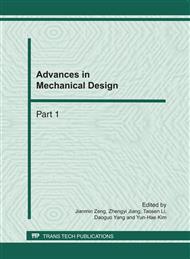p.1292
p.1297
p.1303
p.1308
p.1314
p.1320
p.1324
p.1331
p.1335
The Research on Kinematics and Optimized Design of a Novel Parallel Mechanism with Six Freedoms
Abstract:
This paper proposes a novel parallel mechanism named 3/3-RRRS, and gives a research of direct and inverse solutions to positions of this mechanism. The equations of direct and inverse solutions are proposed by using vector method , and the analytical solutions of the inverse solution are given .There are many factors which influence the workspace, The article analyzes the specific factors that influence the workspace by using the software ADAMS, the workspace will function as a target for agencies to optimize the parameters.
Info:
Periodical:
Pages:
1314-1319
Citation:
Online since:
February 2011
Keywords:
Price:
Сopyright:
© 2011 Trans Tech Publications Ltd. All Rights Reserved
Share:
Citation:


